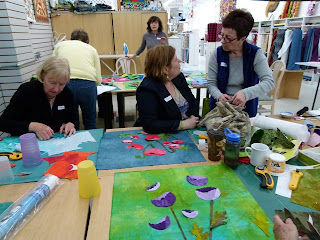With the flour paste resist you paint a paste made of flour and water (something like the consistency of pancake batter) on your fabric. Once it is dry you can take out all your frustrations on it, scrunching it to form cracks in the dried flour paste. After that you paint thickened dyes into the cracks. You can see more information and photos of the method in my January 9, 2011 blog post.
At home in my dungeon, er I mean basement, it usually takes at least 24 hours for the flour paste to dry, but we put them outside on a clear day and many of them were dry in only a few hours. I just love this method!!! Easy and always fabulous results! Reminds me of old walls and walkways in Italy.
Here is the piece that resulted from the demo I did in class. Even my husband remarked on what a stunning fabric this is! I started with a piece of fabric that had already been dyed a butterscotch colour, and painted the cracks with black dye.
Irene sent photos of her completed pieces. Just lovely!
Here is Barb, hamming it up for the camera as I prepare for my demo. By the way, that is a particulate mask on her head (to block the inhalation of dye powder). Normally it is worn over the nose and mouth ;-)) In Barb's hand is a french whisk, one of my favorite tools for soy wax batik, but it can also be used to mix your flour paste resist (although I just use a cheap one from the dollar store).
Below is the soy wax batik station. Students are using various tools (including the french whisk above) to stamp melted wax on their fabric. The wax is melted in an electric frying pan on low heat.
Once the wax hardens, you can pin the fabric to a board and paint thickened dyes on it. This method blocks dye penetration best so you get a crisper image, and also makes it easier to use several colours or have control of where the colour is placed. These are some of the fabrics I have created using this method.
Same method, but in this case I started with white fabric.The waxed fabric can also be placed in a low-water immersion bath for a less crisp and more crinkly image. You can see on the right-hand blue piece below that the waxed images are not as stark white as in the above photo (even though I also started with white fabric in that piece). That is because in the low-water immersion dye bath the fabric is scrunched, and thus leads to a more crinkled design.

Here thickened dyes are being painted on the soy wax batik. In this case three colours were used on the same piece of fabric
This student painted several colours in a more oval pattern.
Fabric is batched for 24 hours and washed. Irene sent these photos of her finished soy wax batik fabrics.
Tuesday I was off to Pembroke to deliver a lecture for the Pembroke Log Cabin Quilters Guild. Pembroke is a two hour drive northwest of Ottawa. There was a great turnout for the lecture.
I stayed overnight and taught my Surface Design class on Wednesday. There is something about getting messy with paint and dye that makes many people happy! This was an introductory class on how to use many surface design products, such as Prismacolor Artist Pencils, Caran D'Ache Neocolor 2 Watersoluble Wax Pastels, Shiva Paintstiks, Tsukineko Inks, and Foils. I will be teaching a full week-long version of this class the week of July 30 - August 3 at the Haliburton School of the Arts. Students will be able to use them in more depth and actually create a small work using each method.
Yesterday I taught my Fast & Fun Fused Designs class at Dragonfly Fabrics in Ottawa. In this class, many students get permission for the first time to cut free-hand without patterns. I never attended kindergarden because it didn't exist where I grew up, so I'm making up for it now! Students are always surprised at how easy it is to cut something stunning once they learn a few tricks and give themselves permission. Many also find it immensely gratifying and liberating.

With fewer workshops in the next two weeks I'll be catching up on paperwork. I owe quite a few groups teaching contracts! I also hope to blog about a few topics other than my teaching trips. Topics I plan to cover include the following: how I dye my multi-coloured fabrics (such as the convergence ones I showed a photo of in my April 19, 2012 post), the thorny issue of copyright, and I hope to share some work from my upcoming drawing and painting class that begins this week. I managed to find one that will fit my schedule with only one or two classes missed!! Yipee! Stay tuned.













Love to read your posts, and love all the pictures, too! I've never used soy wax, i still use the old-fashioned beeswax. Glad to hear that your knee pain might be correctable with surgery in the future. Looking forward to your convergence fabric "secrets".
ReplyDeleteVERY VERY cool, Elaine!
ReplyDelete